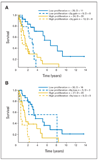Specific secondary genetic alterations in mantle cell lymphoma provide prognostic information independent of the gene expression-based proliferation signature
- PMID: 17296973
- PMCID: PMC2366164
- DOI: 10.1200/JCO.2006.08.4251
Specific secondary genetic alterations in mantle cell lymphoma provide prognostic information independent of the gene expression-based proliferation signature
Abstract
Purpose: To compare the genetic relationship between cyclin D1-positive and cyclin D1-negative mantle cell lymphomas (MCLs) and to determine whether specific genetic alterations may add prognostic information to survival prediction based on the proliferation signature of MCLs.
Patients and methods: Seventy-one cyclin D1-positive and six cyclin D1-negative MCLs previously characterized by gene expression profiling were examined by comparative genomic hybridization (CGH).
Results: Cyclin D1-negative MCLs were genetically characterized by gains of 3q, 8q, and 15q, and losses of 1p, 8p23-pter, 9p21-pter, 11q21-q23, and 13q that were also the most common alterations in conventional MCLs. Parallel analysis of CGH aberrations and locus-specific gene expression profiles in cyclin D1-positive patients showed that chromosomal imbalances had a substantial impact on the expression levels of the genes located in the altered regions. The analysis of prognostic factors revealed that the proliferation signature, the number of chromosomal aberrations, gains of 3q, and losses of 8p, 9p, and 9q predicted survival of MCL patients. A multivariate analysis showed that the gene expression-based proliferation signature was the strongest predictor for shorter survival. However, 3q gains and 9q losses provided prognostic information that was independent of the proliferative activity.
Conclusion: Cyclin D1-positive and -negative MCLs share the same secondary genetic aberrations, supporting the concept that they correspond to the same genetic entity. The integration of genetic information on chromosome 3q and 9q alterations into a proliferation signature-based model may improve the ability to predict survival in patients with MCL.
Figures



References
-
- The Non-Hodgkin‘s Lymphoma Classification Project: A clinical evaluation of the International Lymphoma Study Group classification of non-Hodgkin's lymphoma. Blood. 2006;89:3909–3918. - PubMed
-
- Bosch F, Jares P, Campo E, et al. PRAD-1/cyclin D1 gene overexpression in chronic lympho-proliferative disorders: A highly specific marker of mantle cell lymphoma. Blood. 1994;84:2726–2732. - PubMed
-
- Fernandez V, Hartmann E, Ott G, et al. Pathogenesis of mantle-cell lymphoma: All oncogenic roads lead to dysregulation of cell cycle and DNA damage response pathways. J Clin Oncol. 2005;23:6364–6369. - PubMed
-
- Cuneo A, Bigoni R, Rigolin GM, et al. Cytogenetic profile of lymphoma of follicle mantle lineage: Correlation with clinicobiologic features. Blood. 1999;93:1372–1380. - PubMed
-
- Wlodarska I, Pittaluga S, Hagemeijer A, et al. Secondary chromosome changes in mantle cell lymphoma. Haematologica. 1999;84:594–599. - PubMed
Publication types
MeSH terms
Substances
Grants and funding
LinkOut - more resources
Full Text Sources
Other Literature Sources
Research Materials

